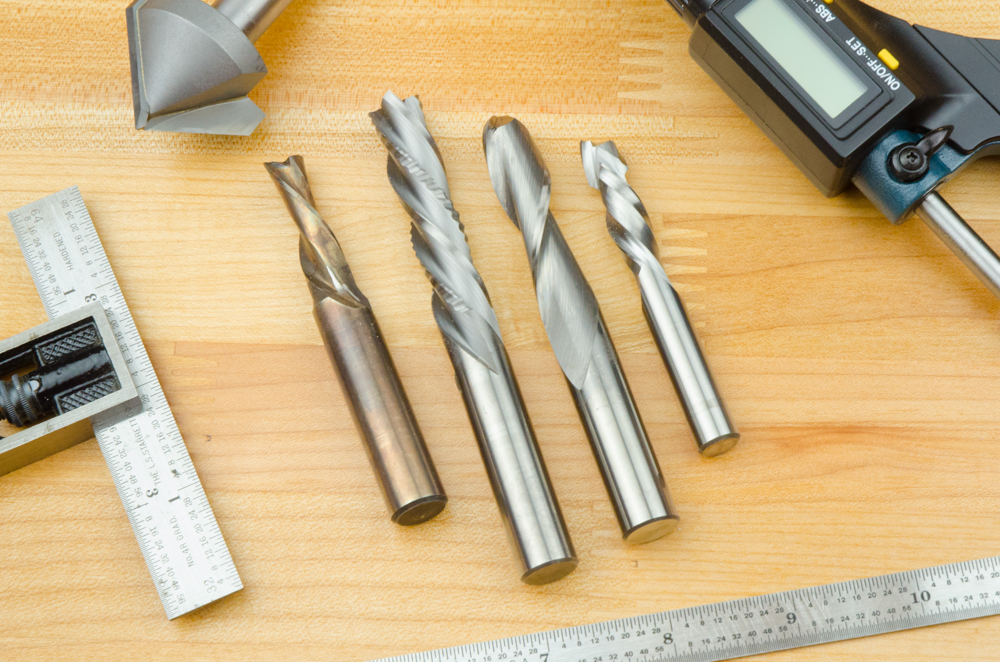We may receive a commission when you use our affiliate links. However, this does not impact our recommendations.

There are a lot of decisions to make when choosing which mill to use in different situations on a CNC.
When woodworkers talk about their favorite hand tools, they might mention a treasured handplane — perhaps a superb pre-WWII Stanley Bedrock smoother outfitted with a Ron Hock blade or a beautiful set of hand forged Fujihiro chisels. A hybrid woodworker might have a Felder combination machine with a slider and tilting shaper or perhaps a carefully restored and finely tuned antique 16” Oliver jointer. The point here is clear. Woodworkers like their tools and tend to be pretty picky when it comes to time to select the ones they’d prefer to use.
You can apply that same pickiness to woodworkers who use digital tools. Besides the search for an ideal CNC machine and CAD/CAM software that you’d really like to use every day, there’s all that tooling that gets attached to the CNC’s spindle or router. These are the rotational cutters referred to as CNC end mills, bits if you like to call them that. Much as a finely tuned handplane, scraper or bandsaw is a real joy to use, when you make the right tooling choices and finely tune your CNC settings for a particular cutting situation, the results are just as satisfying for digital woodworkers.
I’m like most of you. I like my tools to perform well. So, when it comes to CNC tools I tend to be rather picky. A CNC mill is a big subject worth a deeper look. Whether you’re on the outside and just now discovering digital woodworking, a new CNC owner or more experienced, we’ve got a lot to talk about when it comes to CNC cutting tools.
Complicated topic
A cutting tool is a complex subject for any CNC user no matter what purpose you use the machine for. On top of that, in digital woodworking, we have our own special considerations. With all that to cover and thousands of mills to choose from, this will be a multi-part series that I’ll come back to visit again frequently over time.
First up is a CNC mill primer. Down the road, there will be posts on flat mills — these are your workhorse cutting tools used for cutting wood parts, mortises, pockets and joinery. Ball mills are round on the bottom and are the tool of choice for 3D carving. Then, there are miscellaneous cutters like V-bits, fly cutters and other types of end mills for cutting materials other than wood. Also, I’ll put together a basic set of mills for woodworkers. Finally, I’d like to do a few posts about some amazing new CNC mills designed for high-performance digital woodworking.
Before we begin, I should mention that there are many other variables when it comes to operating a CNC machine optimally. There’s spindle rotational speed, CNC feed rates, depth of cut, ramping, hardness of the material you’re cutting and more to consider. Many of these are major CNC woodworking topics all in themselves. And, if you want to get really serious about the mills, you can always add cutter design, geometry, the number of flutes, chip loads, flute angles, etc.
All of these ingredients affect your decision when selecting which cutter to use and how to use it. Fortunately, I have good news. You don’t have to master or even understand all those tiny details to be successful in CNC woodworking. Just a few concepts need to be understood along with taking a few basic approaches. Thankfully, when it comes to selecting which tools to use there are some proven choices that serve you well in most major woodworking situations that you’ll likely run across.
Obviously, we have much to cover and will be returning to the topic of CNC tooling for woodworking tasks a lot over time. So, let’s get started. Next up is part one. A CNC Mill Primer.
Too see the entire series on CNC Tooling Basics, click here.
Here are some supplies and tools we find essential in our everyday work around the shop. We may receive a commission from sales referred by our links; however, we have carefully selected these products for their usefulness and quality.









David,
I’ve never broken and end mill before. Boy, I wish that was true…
The reason most people break bits is because they cut too fast or too deep, or both. If you’re using bits under .250 you have to be particularly careful about your settings as it’s just way too easy to break them. Just as common a cause is breaking a bit on a clamp as the CNC does a rapid move between positions on the table. For that reason, I always suggest that you make sure your starting point is within the “field of play” as I call it. Always start inside the clamped area.
Great to see this discussion. As a new CNC woodworker I am discovering how to best break my end mills … and more correctly and hopefully how to avoid doing so! Looking forward to following the discussion.